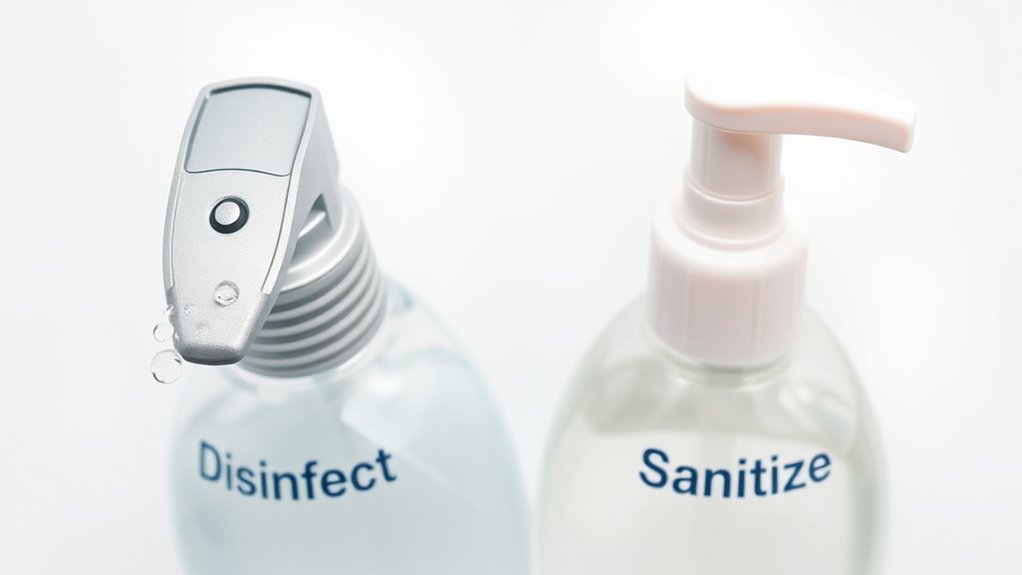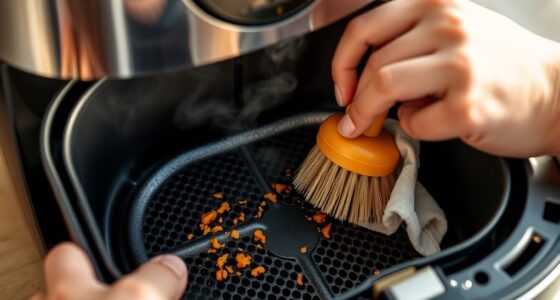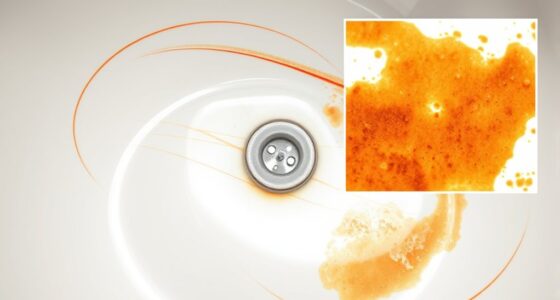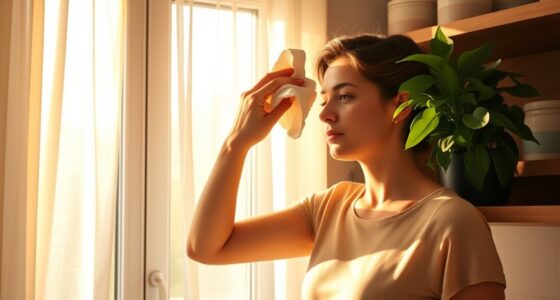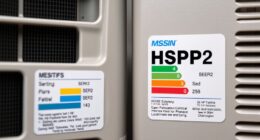When you see labels for disinfecting or sanitizing, understand that disinfectants kill most germs, bacteria, and viruses using stronger chemicals for deeper, longer-lasting effects. Sanitizers, on the other hand, just reduce germs to safe levels, offering quick, surface-level cleaning suitable for everyday items. Knowing these differences helps you choose the right product for your needs. Keep exploring to learn how to select and use them effectively for your environment.
Key Takeaways
- Disinfecting kills germs, bacteria, and viruses using strong chemicals, while sanitizing reduces microbes to safe levels for everyday use.
- Disinfectants offer deeper surface penetration and longer-lasting effects compared to sanitizers, which have shorter residual activity.
- Labels like “kills 99.9% of germs” and certifications from EPA or FDA indicate product effectiveness and regulatory approval.
- Proper application and contact time are essential to maximize germ reduction for both disinfectants and sanitizers.
- Choose products compatible with your surface material to prevent damage and ensure effective, safe cleaning.
Defining Disinfecting and Sanitizing
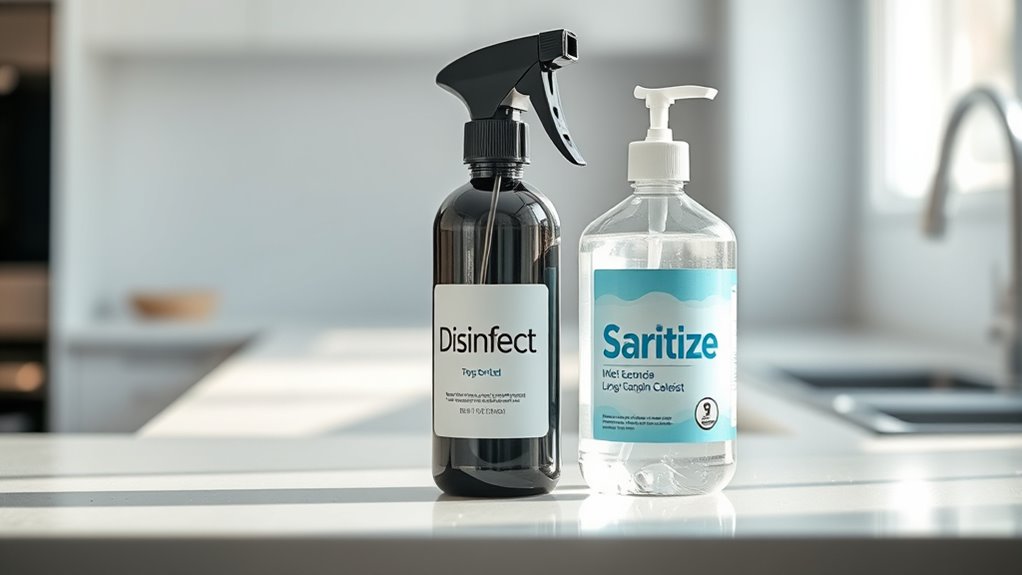
Disinfecting and sanitizing are often used interchangeably, but they serve different purposes in cleanliness. Disinfecting involves killing germs, bacteria, and viruses on surfaces, often using stronger chemicals or methods. Sanitizing reduces the number of germs to a safe level, which is especially important in everyday settings like kitchens and bathrooms. If you’re interested in eco-friendly options, you can explore DIY solutions such as vinegar or hydrogen peroxide, which are effective and less harmful to the environment. These eco friendly options are great for those wanting to avoid harsh chemicals. Understanding the distinction helps you choose the right approach for your needs, whether you’re aiming for thorough disinfecting or simple sanitizing, all while incorporating sustainable solutions. Incorporating natural materials and mindful cleaning techniques can enhance both cleanliness and the overall ambiance of your space.
The Science Behind Germ Reduction
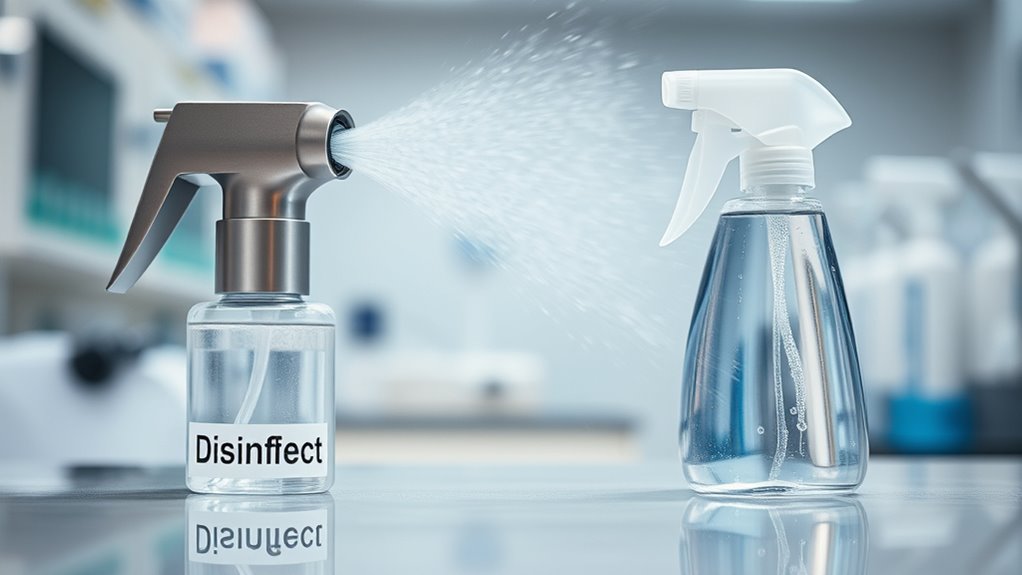
Understanding how disinfectants and sanitizers reduce germs depends on their microbial kill rates and how long their effects last. You need to contemplate how quickly they eliminate bacteria and viruses, as well as how long surfaces stay protected afterward. This science helps you choose the right method for effective germ control. Incorporating knowledge about biodiversity can also inform better cleaning practices that support environmental health and sustainability.
Microbial Kill Rates
To effectively reduce germs, it’s essential to understand how disinfectants and sanitizers kill microbes. Microbial kill rates depend on factors like surface penetration and residual activity. Disinfectants often penetrate surfaces more deeply, reaching microbes hidden in crevices, which improves kill efficiency. Sanitizers typically have shorter contact times and less surface penetration but can be effective for surface-level microbes. Residual activity refers to how long a product continues to kill or inhibit microbes after application. Some disinfectants leave a lasting barrier, providing ongoing protection. Integration with other tools can enhance the overall effectiveness of germ reduction strategies. Key points to contemplate include:
- Surface penetration enhances germ contact
- Residual activity prolongs effectiveness
- Kill rates vary with contact time
- Different formulations target different microbes
Understanding these factors helps you choose the right product for your needs.
Effectiveness Duration
The length of time a germ-killing product remains effective after application varies considerably between disinfectants and sanitizers. Disinfectants typically offer longer-lasting surface longevity due to residual effects that continue killing germs after application. These residual effects help keep surfaces safer over extended periods, especially in high-touch areas. Sanitizers, on the other hand, generally provide a more immediate reduction in germs but lack sustained surface longevity. Their effectiveness diminishes quickly once the surface dries or is touched. If you’re aiming for ongoing germ control, choosing a disinfectant with proven residual effects can be more effective. Proper application and contact time are essential to maximize these benefits, and understanding the air purification features can further enhance overall indoor hygiene.
Common Ingredients and Their Roles
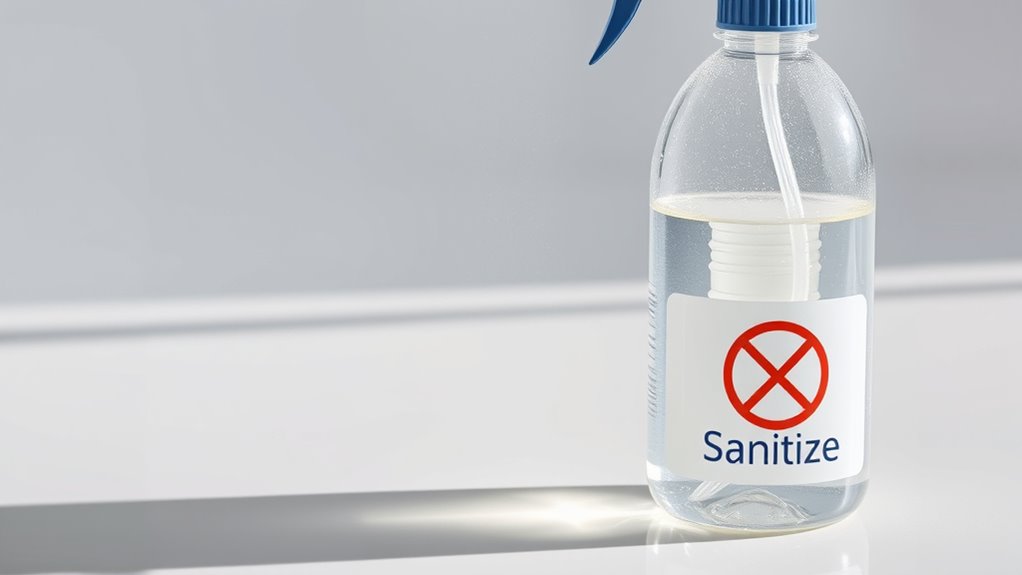
Many disinfectants and sanitizers rely on specific ingredients that effectively kill germs and reduce bacteria on surfaces. These ingredients work through chemical interactions that disrupt microbial cell structures or metabolic processes. Understanding their roles helps you choose safer, more effective products. For example:
- Alcohols: Denature proteins and dissolve lipids, destroying cell membranes.
- Chlorine compounds: Oxidize cellular components, leading to microbial death.
- Quaternary ammonium compounds: Disrupt cell membranes and inhibit enzyme activity.
- Hydrogen peroxide: Produces reactive oxygen species that damage DNA and proteins.
When selecting products, consider ingredient safety and how these chemical interactions may affect surfaces or your health. Knowing the common ingredients helps you make informed choices for effective and safe disinfection.
Label Claims and Regulatory Standards
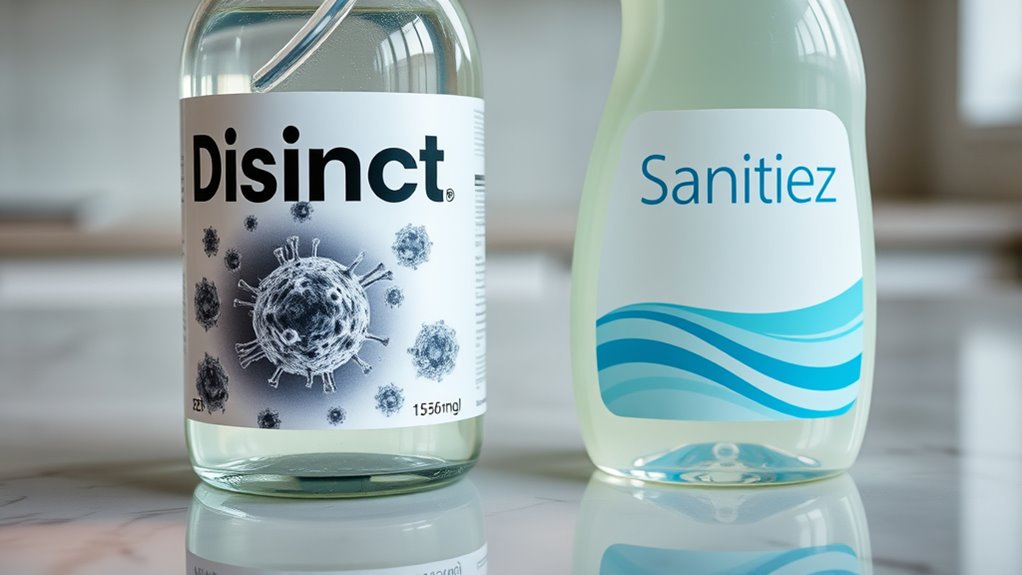
Understanding the ingredients in disinfectants and sanitizers is important, but equally essential is knowing what their labels claim and how regulatory standards govern these statements. Label terminology can often be confusing, so it’s vital to recognize what claims like “kills 99.9% of germs” truly mean. Regulatory compliance ensures that these claims are backed by scientific testing and official approvals. The table below clarifies common label claims:
| Label Claim | Meaning | Regulatory Standard |
|---|---|---|
| Kills bacteria | Reduces bacterial presence | EPA/FDA approval |
| Sanitizes | Lowers bacteria to safe levels | Industry guidelines |
| Disinfects | Eliminates most pathogens | EPA registration |
| EPA Registered | Meets official regulatory approval | Regulatory compliance |
Knowing these distinctions helps you make informed choices for safety. For example, understanding regulatory standards can help verify the effectiveness claims on product labels.
When to Use Disinfectants vs. Sanitizers
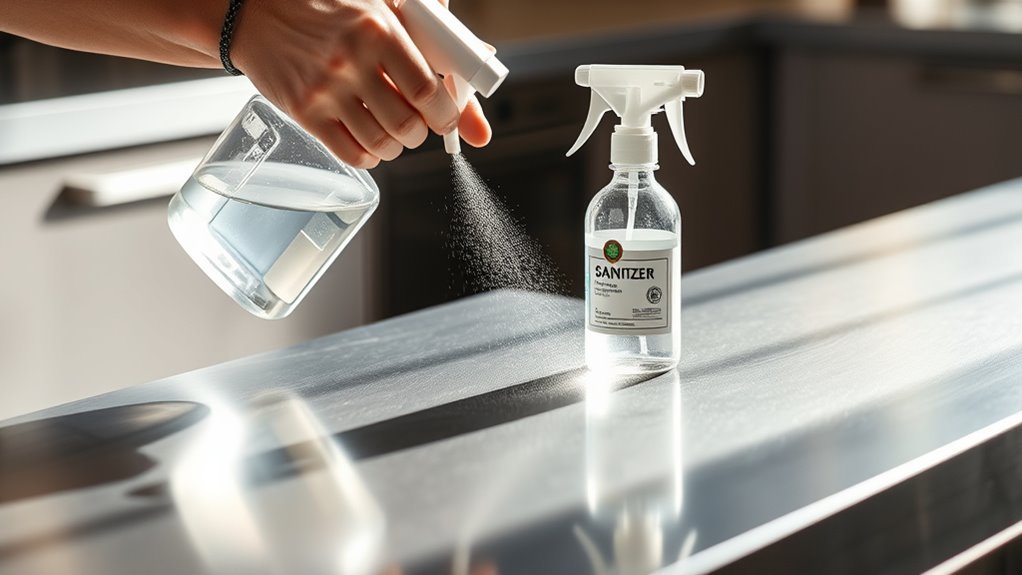
Choosing between disinfectants and sanitizers depends on the situation and the level of cleanliness required. You should consider factors like surface compatibility and environmental impact. Use disinfectants when surfaces are heavily contaminated or need sterilization, such as in healthcare settings. Sanitizers are suitable for everyday use on items like utensils and hands, where bacteria reduction is enough. Keep in mind:
- Disinfectants may be harsh and less compatible with delicate surfaces.
- Sanitizers generally have a lower environmental impact and are gentler.
- For electronics or sensitive materials, verify compatibility before applying.
- In high-traffic areas, disinfectants provide a more thorough clean, but consider environmental effects.
- Understanding the difference between disinfecting and sanitizing helps ensure proper application and safety.
Evaluate your specific needs to choose the right product, balancing effectiveness with surface safety and environmental concerns.
Tips for Choosing the Right Product

When selecting a disinfectant or sanitizer, you should carefully read the product labels to understand its intended use. Think about the surface you’re treating and whether the product is compatible to avoid damage. Making these checks helps guarantee you choose the most effective and safe option for your needs. Additionally, consider whether the product contains added sugars or unnecessary ingredients that could compromise its effectiveness or safety.
Check Product Labels Carefully
To make certain you’re selecting the right disinfectant or sanitizer, carefully reading product labels is essential. Labels specify active ingredients, contact time, and surface compatibility, which influence chemical reactions and effectiveness. Pay attention to safety precautions, such as proper ventilation or protective gear, to prevent accidents. Additionally, check for clear instructions on how to use the product safely. Look for certifications or approvals from health authorities to ensure reliability. Being aware of essential oils for health, such as eucalyptus or tea tree oil, can also guide you in choosing natural alternatives when appropriate.
Consider Surface Compatibility
Since surfaces vary widely in material and texture, evaluating their compatibility with disinfectants and sanitizers is crucial. Different surfaces have varying levels of surface durability, which determines how well they withstand cleaning products without damage. For high-traffic areas that require frequent cleaning, choose products labeled safe for frequent use to prevent deterioration. Delicate surfaces like wood or glass may need gentler formulas, while more durable materials like tile or stainless steel can handle stronger disinfectants. Always read product labels to ensure compatibility with your specific surfaces. Using incompatible products can cause discoloration, warping, or other damage, ultimately reducing surface longevity. Additionally, understanding the surface durability of materials helps prevent the use of overly harsh chemicals that could compromise their integrity. By considering surface durability and cleaning frequency, you can select the most effective and safe disinfectant or sanitizer for each area.
Frequently Asked Questions
Can a Product Be Both a Disinfectant and a Sanitizer Simultaneously?
Yes, a product can be both a disinfectant and a sanitizer simultaneously by being a dual action product or combined disinfectant sanitizer. These products are designed to clean surfaces effectively, reducing germs and bacteria to safe levels. You’ll find them useful because they simplify cleaning routines, saving you time and effort. Just verify you follow the label instructions to achieve the desired disinfecting and sanitizing effects properly.
Are There Natural or Eco-Friendly Disinfectants and Sanitizers Available?
Think of natural disinfectants as a breath of fresh air for your home. Yes, plant-based options exist that are both effective and eco-friendly, harnessing botanical power to clean without harsh chemicals. Look for eco-friendly certifications like USDA Organic or EPA’s Safer Choice label, which ensure your disinfectant or sanitizer is gentle on the planet while still protecting your space. You’re making a wise choice, blending safety and sustainability seamlessly.
How Long Does It Take for Disinfectants and Sanitizers to Work Effectively?
You need to give disinfectants and sanitizers enough contact time—usually between one to ten minutes—so they can work effectively. Check the label for recommended contact time, as it varies by product. Also, consider surface compatibility; some disinfectants may damage certain materials. Ensuring proper contact time and surface compatibility guarantees that germs are properly killed or reduced, keeping your environment safer.
Do Disinfectants and Sanitizers Kill Viruses, Bacteria, or Both?
Imagine a powerful shield enveloping your space—that’s what disinfectants and sanitizers do. They kill both viruses and bacteria, thanks to their antimicrobial effectiveness. Disinfectants boast a broad spectrum, targeting a wide range of pathogens, including viruses, while sanitizers primarily reduce bacteria. So, yes, these solutions work on both, but disinfectants are your best bet for all-encompassing protection against viruses and bacteria alike.
Are There Specific Certifications to Look for on Disinfectant and Sanitizer Labels?
You should look for certification standards on disinfectant and sanitizer labels to guarantee their effectiveness and safety. Certifications like EPA registration or NSF approval indicate that the product meets strict standards for label accuracy and disinfecting claims. These credentials help you verify that the product has been tested and proven to kill germs, bacteria, or viruses effectively, giving you confidence in its use around your home or workplace.
Conclusion
Understanding the difference between disinfecting and sanitizing helps you make smarter choices for your health. Did you know that improper use of these products can reduce germs by up to 99.9%? By selecting the right product and following label instructions, you protect yourself and your loved ones effectively. Remember, disinfectants usually kill more germs than sanitizers, but knowing when each is appropriate makes all the difference. Stay informed and keep your space safe!
